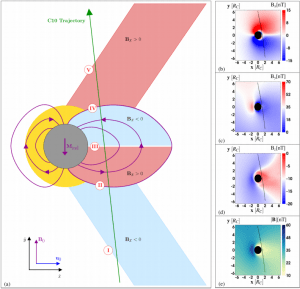This page is no longer maintained. Please go to my new website for an updated list of my publications.
2019

- H. Arnold, L. Liuzzo, and S. Simon, (2019), Magnetic Signatures of a Plume at Europa during the Galileo E26 Flyby, Geophys. Res. Lett., 46, 1149-1157, doi:10.1029/2018GL081544.
In this study, we have identified the signature of a plume at Europa using magnetic field data from the Galileo E26 flyby. This result suggests the presence of persistent plume activity at Europa during the Galileo era.

- Liuzzo, L., S. Simon, and L. Regoli (2019), Energetic ion dynamics near Callisto, Planet. Space Sci., 166, 23-53, doi:10.1016/j.pss.2018.07.014.
This study uses an energetic ion test particle model to understand the effect that electromagnetic perturbations generated by Callisto’s thermal plasma environment has on energetic ion dynamics near the moon and accessibility of these ions to the moon. We find that over the course of a single synodic rotation of Callisto, the moon’s highly variable plasma environment has a significant on accessibility of Callisto to the energetic ion population.
2018

- L. Liuzzo, L., S. Simon, and M. Feyerabend (2018), Observability of Callisto’s inductive signature during the JUpiter ICy moons Explorer mission, J. Geophys. Res. Space Physics, 123, 9045-9054, doi:10.1029/2018JA025951.
In this study, we provide a detailed forecast of the magnetic field signatures that will be observable during all 12 planned Callisto flybys of the JUICE mission. We demonstrate that a large subset of the currently planned flybys will not be suitable to unambiguously disentangle Callisto’s inductive signature from plasma effects.

- Exner, W., D. Heyner, L. Liuzzo, U. Motschmann, D. Shiota, K. Kusano, and T. Shibayama (2018), Coronal mass ejection hits Mercury: A.I.K.E.F. hybrid-code results compared to MESSENGER data, Planet. Space Sci., 153, 89-99, doi:10.1016/j.pss.2017.12.016.
This study applies the AIKEF hybrid simulation model to investigate Mercury’s magnetospheric response to an impinging Coronal Mass Ejection (CME). Using AIKEF and data from the MESSENGER spacecraft, we show that parameters that characterize the CME vary on timescales much smaller than Mercury’s interaction.
2017

- Feyerabend, M., L. Liuzzo, S. Simon, and U. Motschmann (2017), A three-dimensional model of Pluto’s interaction with the solar wind during the New Horizons encounter, J. Geophys. Res. Space Physics, 122, 10,356-10,368. doi:10.1002/2017JA024456.
This study uses the AIKEF hybrid simulation model to investigate Pluto’s interaction with the solar wind during the New Horizons flyby of Pluto.We show that the large gyroradii of ions near Pluto generate non-negligible asymmetries in Pluto’s plasma and magnetic environment, and any modeling attempts must consider these asymmetric features.

- Liuzzo, L., S. Simon, M. Feyerabend, and U. Motschmann (2017), Magnetic signatures of plasma interaction and induction: The Galileo C21, C22, C23, and C30 flybys,J. Geophys. Res. Space Physics,122, 7364-7386. doi:10.1002/2017JA024303.
This study focused on the final four flybys of Callisto during the Galileo Mission. By using the AIKEF hybrid simulation model, we determined that no signatures of Callisto’s subsurface ocean were detected in magnetometer data during the C21, C22, C23, and C30 flybys. This study also constrained the geometry of future flybys of Callisto that aim to detect the moon’s inductive response in magnetic field data.
2016

- Liuzzo, L., S. Simon, M. Feyerabend, and U. Motschmann (2016), Disentangling plasma interaction and induction signatures at Callisto: The Galileo C10 flyby,J. Geophys. Res. Space Physics,121, 8677-8694. doi:10.1002/2016JA023236.
This study used the AIKEF hybrid simulation model to investigate magnetometer and plasma data from the Galileo C10 flyby of Callisto. In modeling Callisto’s plasma interaction with an ionosphere and induced dipole, this study identified a region in Callisto’s geometric plasma shadow directly downstream of the moon where Callisto’s inductive response was unobscured by Callisto’s plasma interaction with the Jovian magnetosphere.
2015
 Liuzzo, L., M. Feyerabend, S. Simon, and U. Motschmann (2015), The impact of Callisto’s atmosphere on its plasma interaction with the Jovian magnetosphere,J. Geophys. Res. Space Physics,120, 9401–9427. doi:10.1002/2015JA021792.
Liuzzo, L., M. Feyerabend, S. Simon, and U. Motschmann (2015), The impact of Callisto’s atmosphere on its plasma interaction with the Jovian magnetosphere,J. Geophys. Res. Space Physics,120, 9401–9427. doi:10.1002/2015JA021792.
This study investigated the interaction of Callisto with Jupiter’s magnetospheric plasma for differing properties of Callisto’s atmosphere and ionosphere using the hybrid simulation model AIKEF. Key scenarios that were investigated included varying the angle of incoming solar radiation with respect to the impinging magnetospheric plasma, as well as simulations where Callisto’s distance to the center of Jupiter’s magnetospheric current sheet was changed.

- Feyerabend, M., S. Simon, U. Motschmann, and L. Liuzzo (2015), Filamented ion tail structures at Titan: A hybrid simulation study, Planet. Space Sci., 117, 362-376. doi:10.1016/j.pss.2015.07.008
This study used the AIKEF hybrid simulation model to investigate three Cassini flybys of the Saturnian moon Titan. By comparing model output to magnetic field and plasma data, the study found that observations of a “split tail” of heavy ions downstream of Titan is an omnipresent feature of Titan’s plasma interaction with the Saturnian magnetosphere.
- , , , , , , , and (2015), High-latitude ionospheric drivers and their effects on wind patterns in the thermosphere, J. Geophys. Res. Space Physics, 120, 715–735. doi:10.1002/2014JA020553.
This study used the Global Ionosphere-Thermosphere Model to comstrain the effects that various high-latitude ionospheric drivers have on wind patterns in the upper thermosphere


